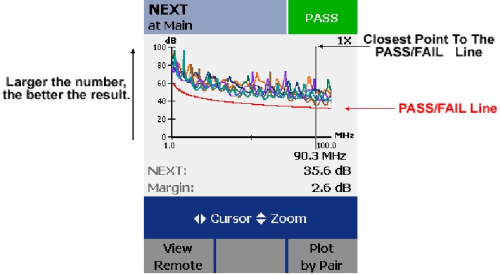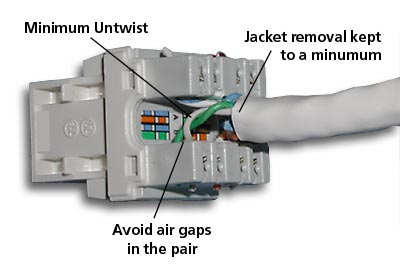NEXT (Near-End Crosstalk) Troubleshooting
Are you looking to troubleshoot NEXT problems? Why not try:
- Case Study 1 - Marginal NEXT Pass on a DTX CableAnalyzer
- Case Study 2 - NEXT Fails on DTX CableAnalyzer due to cable
- Case Study 5 - NEXT Fails on DTX CableAnalyzer due to a termination issue
- Case Study 7 - NEXT fails on DTX CableAnalyzer due to non component compliant connector
When a current flows through a wire, an electromagnetic field is created which can interfere with signals on adjacent wires. As frequency increases, this effect becomes stronger. Each pair is twisted because this allows opposing fields in the wire pair to cancel each other. The tighter the twist, the more effective the cancellation and the higher the data rate supported by the cable. Maintaining this twist ratio is the single most important factor for a successful installation.
If wires are not tightly twisted, the result is Near End Crosstalk (NEXT). Most of us have experienced a telephone call where we could hear another conversation faintly in the background. This is crosstalk. In fact, the name crosstalk derives from telephony applications where 'talk' came 'across'. In LANs, NEXT occurs when a strong signal on one pair of wires is picked up by an adjacent pair of wires. NEXT is the portion of the transmitted signal that is electromagnetically coupled back into the received signal.

Results Interpretation
Since NEXT is a measure of difference in signal strength between a disturbing pair and a disturbed pair, a larger number (less crosstalk) is more desirable than a smaller number (more crosstalk). Because NEXT varies significantly with frequency, it is important to measure it across a range of frequencies, typically 1 100 MHz. If you look at the NEXT on a 50 meter segment of twisted pair cabling, it has a characteristic "roller coaster going uphill" shape. That is, it varies up and down significantly, while generally increasing in magnitude. This is because twisted pair coupling becomes less effective for higher frequencies.

The field tester should compare successive readings across the frequency range against a typical pass/fail line, such as the Class D specification. If the NEXT curve crosses the pass/fail line at any point, then the link does not meet the stated requirement. Since NEXT characteristics are unique to each end of the link, six NEXT results should be obtained at each end.
Troubleshooting Recommendations
In many cases, excessive crosstalk is due to poorly twisted terminations at connection points.
From the standard ANSI/TIA-568-C.0
It is essential to maintain the design performance of connecting hardware when terminated to a balanced twisted-pair cable, and this shall be achieved by terminating the appropriate connecting hardware for that balanced twisted-pair cable in accordance with the connecting hardware manufacturer’s instructions. Where no connecting hardware manufacturer’s instructions exist, then the cable geometry shall be maintained as close as possible to the connecting hardware, and its cable termination points and the maximum pair un-twist for the balanced twisted-pair cable termination shall be in accordance with table 1.
Table 1 states 13 mm (0.5 in) for Category 5e, 6 and 6A. An additional note common to all standards is that the amount of untwist should be kept to a minimum. Experience has shown that 13mm does not guarantee a PASS when field testing.

The first thing to do in the event of a NEXT failure is to use the field tester to determine at which end the NEXT failure occurred. Once this is known, check the connections at that end and replace or re-terminate as appropriate. Many testers have a time domain feature, the ability to look down the cable and see where the crosstalk is happening. The example below is take from a DTX CableAnalyzer. The feature is called HDTDX.
If this does not appear to be the problem, check for the presence of lower Category patch cords (such as voice grade cable in a Class D installation). Another possible cause of NEXT failures are split pairs. These can be identified automatically with the wiremap function of your field tester. Female couplers are another high source of crosstalk and should not be used in a data installation. If a cable is not long enough, replace it with a cable of the required length rather than adding another cable.
Sometimes a NEXT failure is caused by an inappropriate test being selected. For example, you cannot expect a Category 5 installation to meet Category 5e performance requirements.
The best method for troubleshooting NEXT is to use a tester with Time Domain capabilities. This gives the tester the ability to show the fault by distance, pinpointing the problem. This diagnostic function clearly identifies the cause of the NEXT failure, whether it's the patch cord, connection, or horizontal cable.
In the event you have eliminated all of the above NEXT sources and are still experiencing NEXT failures, contact the system designer for further assistance.






